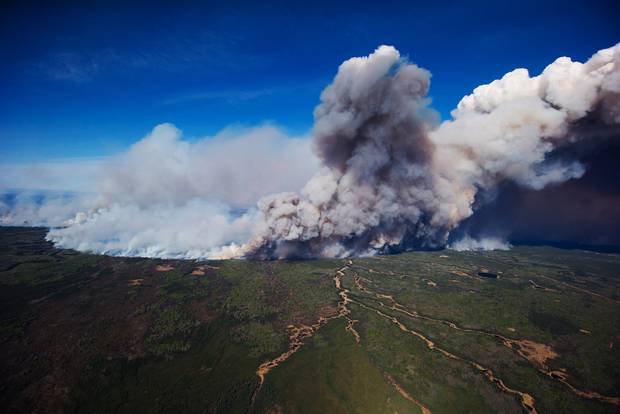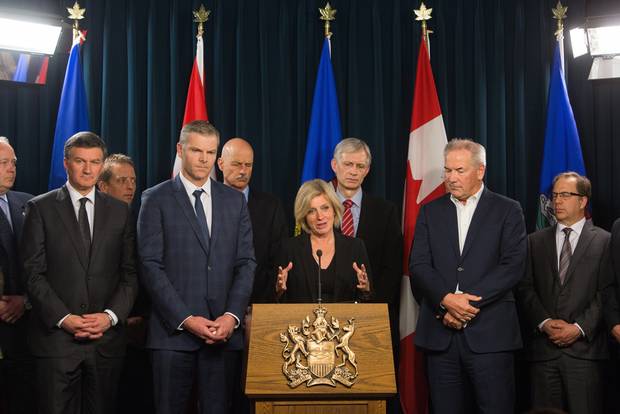
The Syncrude Canada Ltd. mine stands at the Athabasca oil sands in this aerial photograph taken near Fort McMurray, Alberta, Canada, on Thursday, June 4, 2015.
Ben Nelms/Bloomberg
The wildfires in the Fort McMurray region have placed the spotlight on an industry that has been reeling from low oil prices. Here is a look at the ripple effects in the oil sands.
Shutdowns
Syncrude Canada Ltd. and Suncor Energy Inc. are the two largest operators, each with a capacity of 350,000 barrels a day at their main plants. With the evacuation of Fort McMurray last week, thousands of employees and their families exited. Projects such as those operated by Syncrude and Suncor relied on essential staff to carry out controlled shutdowns. Smoke became a concern in the days after the evacuation on May 3, though the operators said on the weekend that there wasn't any danger to workers on site or to the facilities.
The major operations, located north of Fort McMurray, have a long history in the region. Suncor opened in 1967, while Syncrude became the second oil sands facility when it opened its Mildred Lake plant in 1978. Syncrude and Suncor transform tar-like bitumen into synthetic light crude. Four of the 11 plants that shut down are located south of the city: Surmont, Long Lake, Leismer and Hangingstone.
Production impact
While precise production numbers for each project haven't been disclosed by the energy producers, ARC Financial Corp. estimates that earlier this week, there were 1.2 million barrels of oil a day that had been taken off-line. That represents 48 per cent of the daily output of 2.5 million barrels from northern Alberta's oil sands in early 2016. While there are both higher and lower estimates on the number of barrels knocked out due to the plant shutdowns, industry analysts agree that at the peak of the wildfire's impact, Alberta lost at least one million barrels a day of output.
Goldman Sachs reckons that 14 million barrels of production will be lost in May, or the equivalent of more than 650,000 barrels a day over a three-week period, assuming the plants gradually ramp up later this month. "So far, the only reported damage to oil-producing facilities has been minor damage to Nexen's Long Lake facility (production was already reduced prior to the fire)," Goldman Sachs said in a research note. The value of the lost production in May could be as much as $760-million, according to some observers.
Oil price impact
Oil prices rose initially after last week's plant shutdowns. "The reason the oil price did not gain more is because, at this point, the shut-ins are expected to be short term – that is, assuming that there continues to be no lasting damage to facilities or critical infrastructure such as power lines or pipelines," ARC Financial said in a research note. Goldman Sachs described the plant shutdowns as significant, though not enough to lift oil prices for long. Slumping oil markets since 2014 had already crimped Alberta's economic growth.
"There is an economic consequence to taking production off-line. There is forgone revenue to both companies and to the Crown," Alberta Premier Rachel Notley said. The effects will be felt beyond Alberta. A forecast released Wednesday by Bank of Nova Scotia said Canada's real gross domestic product is expected to fall by an annualized 0.5 per cent in the second quarter of 2016. "The renewed slump in non-energy exports is compounded by the falloff in crude-oil shipments due to the Fort McMurray wildfires," Scotiabank said. A report by National Bank Financial Inc. said GDP growth could bounce back in the third quarter, with worst-case scenarios now averted.

A huge plume of smoke from wildfires burning rises in this aerial photograph taken above Fort McMurray, Friday, May 6, 2016.
Darryl Dyck/Bloomberg
Getting restarted
Ms. Notley met on Tuesday with Suncor chief executive officer Steve Williams and other oil bosses to map plans to get the plants up and running. "We agree that operations will only restart when it is absolutely safe to do so," she said. Mr. Williams said there was no damage to the sites north of Fort McMurray. "Our employees are very keen to get back in," he said. "Some facilities are simply turning up the volumes now. Some will be more difficult and could be a week or two."
Highway 63, the crucial route through Fort McMurray that got cut off last week, reopened on Tuesday to traffic headed to the oil sites north of the city. That is important because it allows workers and contractors to regain access and deliver supplies. "The dislocation of oil sands employees and their families from Fort McMurray has created challenges – none of which are insurmountable, given sound planning and the resolve of Albertans," RBC Dominion Securities Inc. said in a report on Wednesday titled Phoenix Rising.

Premier Rachel Notley speaks to the media along with Suncor President and CEO Steve Williams, right, and President and CEO Canadian Association of Petroleum Producers Tim McMillan, left, at the Alberta Legislature in Edmonton, Alberta, on Tuesday, May 10, 2016. They met to discuss recovery strategies, including prioritizing restarting industrial activities, moving forward in Fort McMurray after the devastating wildfires.
Amber Bracken/THE CANADIAN PRESS
Future of oil sands
It is shaping up to be a year of flat growth in production in the oil sands, given the setbacks.
"While output is expected to eventually return in line with the earlier uptrend, oil firms will never make up for the lost output during the interruption," National Bank said. There is only one major new project under construction in the oil sands: The $15-billion Fort Hills joint venture, located 90 kilometres north of Fort McMurray, is slated to open in late 2017. Fort Hills is led by Suncor, which holds a 50.8-per-cent stake. Its partners are France's Total SA and Vancouver-based Teck Resources Ltd.
DBRS Ltd. said there has been little to no damage to facilities from the wildfires. "DBRS considers the impact on credit profiles to be minimal," the rating agency said. In the long term, despite the cancellation of planned projects in northern Alberta during the slump in global energy markets, the oil sands are forecast to maintain a leading role in Canada's oil and gas industry. Nearly 60 per cent of the country's oil production comes from the oil sands, and the region is expected to drive future production growth, the National Energy Board said in a report released Wednesday.
It is unclear how fast or slowly the oil sands will expand in the years and decades ahead. "Oil production growth will depend on future prices and pipeline development," the NEB cautioned. Proposals that industry executives say are crucial to the oil sands' future include Enbridge Inc.'s Northern Gateway oil pipeline plans from Bruderheim, Alta., to Kitimat, B.C., and Kinder Morgan Canada's proposed expansion of its Trans Mountain oil pipeline from the Edmonton area to Burnaby, B.C. Both those proposals face opposition from environmentalists and many First Nations in British Columbia.